

Coding4Fun - 試玩 SHA256 密碼雜湊暴力破解
source link: https://blog.darkthread.net/blog/brute-force-cracking-sha256/
Go to the source link to view the article. You can view the picture content, updated content and better typesetting reading experience. If the link is broken, please click the button below to view the snapshot at that time.

試玩 SHA256 密碼雜湊暴力破解-黑暗執行緒
早上提到我的 SCH (Self-Contained Html) SideProject,文件保護是「用密碼字串 SHA256 雜湊當金鑰加隨機 IV 對內容做 AES256 加密」,但因解密會在瀏覽器執行,JavaScript 端解密邏輯是公開的祕密,有心想破解的人,寫支程式用不同密碼嘗試解密,就是最簡單的暴力破解。
嚴格來說,「用密碼字串的 SHA256 雜湊產生金鑰」不算專業設計,理由是 SHA256 運算不夠複雜,擋不住當代 CPU/GPU 的強大運算能力。要有效保護密碼,通常建議使用 PBKDF2、Scrypt、Bcrypt、Argon2... 等密碼專用雜湊演算法,它們的共同特色是每次計算雜湊要花的資源是 SHA256 的 N 倍,對駭客而言,暴力攻擊成本將被放大數百萬倍,幾已無實現可能。延伸閱讀:密碼要怎麼儲存才安全?該加多少鹽?-科普角度
講到這裡,我開始好奇:從專業角度,用 SHA256 強度不足有可能被攻破,但實際難度如何,能擋下我這種非專業駭客用 i5 發動攻擊嗎?感覺挺好玩的,不如就來試試。
SCH 目前使用的加密演算法如下。用密碼字串產生 SHA256 雜湊(byte[32] 256bit)當 AES Key、Random().NextBytes() 隨機生成 byte[16] 當 IV 執行 AES256 加密 1KB 的資料:
using System;
using System.IO;
using System.Security.Cryptography;
using System.Text;
public class CodecNetFx
{
private class AesKeyIV
{
public Byte[] Key = new Byte[32];
public Byte[] IV = new Byte[16];
public AesKeyIV(string strKey)
{
var sha = SHA256.Create();
var hash = sha.ComputeHash(Encoding.ASCII.GetBytes(strKey));
Array.Copy(hash, 0, Key, 0, 32);
new Random().NextBytes(IV);
}
}
public static (byte[] data, byte[] iv) AesEncrypt(string key, byte[] data)
{
var keyIv = new AesKeyIV(key);
var aes = Aes.Create();
aes.Key = keyIv.Key;
aes.IV = keyIv.IV;
using (var ms = new MemoryStream())
{
using (var cs = new CryptoStream(ms,
aes.CreateEncryptor(), CryptoStreamMode.Write))
{
cs.Write(data, 0, data.Length);
cs.FlushFinalBlock();
return (ms.ToArray(), keyIv.IV);
}
}
}
public static byte[] AesDecrypt(string key, byte[] data, byte[] iv)
{
var keyIv = new AesKeyIV(key);
var aes = Aes.Create();
aes.Key = keyIv.Key;
aes.IV = iv;
using (var ms = new MemoryStream(data))
{
using (var cs = new CryptoStream(ms,
aes.CreateDecryptor(), CryptoStreamMode.Read))
{
using (var sr = new StreamReader(cs))
{
using (var dec = new MemoryStream())
{
cs.CopyTo(dec);
return dec.ToArray();
}
}
}
}
}
}
程式模擬三種密碼字元組合:純數字(0-9)、數字加大小寫字母、數字字母加符號(ASCII 32 ~ 126),指定不同密碼長度,程式會試遍所有可能的字串組合,來測能否猜到隨機產生的密碼並測量跑完所有組合的時間。
我的第一個版本,靠遞迴列舉所有組合,解密部分則用 Task.Run() 跑平行運算(延伸閱讀:新時代 .NET ThreadPool 程式寫法)火力全開,
using System.Diagnostics;
int pwdLength = 3;
string pwdCharSet = "*"; // N-Number, A-AlphaDigit, *-Any
int minThreads = Environment.ProcessorCount * 4;
int maxQueueItems = 65536;
if (args.Length > 0)
int.TryParse(args[0], out pwdLength);
if (args.Length > 1)
pwdCharSet = args[1];
if (args.Length > 2)
int.TryParse(args[2], out minThreads);
if (args.Length > 3)
int.TryParse(args[3], out maxQueueItems);
// 密碼字元範圍:ASCII 32~126
char[] pwdChars;
switch (pwdCharSet.ToUpper())
{
case "N":
pwdChars = "0123456789".ToArray();
break;
case "A":
pwdChars = "0123456789ABCDEFGHIJKLMNOPQRSTUVWXYZabcdefghijklmnopqrstuvwxyz".ToArray();
break;
default: // All
pwdChars = Enumerable.Range(32, 95).Select(i => (char)i).ToArray();
break;
}
// 原始資料:1KB byte[]
var plain = new byte[1024];
// 隨機密碼:4字元
var password = new string(Enumerable.Range(0, pwdLength).Select(i => pwdChars[new Random().Next(pwdChars.Length)]).ToArray());
var ecn = CodecNetFx.AesEncrypt(password, plain);
Console.ForegroundColor = ConsoleColor.Yellow;
Console.WriteLine("SAH256 產生 AES256 金鑰暴力破解測試");
Console.ResetColor();
Console.WriteLine($"密碼長度: {pwdLength}");
Console.WriteLine($"可用密碼字元: {new string(pwdChars)}");
Console.ForegroundColor = ConsoleColor.Green;
Console.WriteLine($"隨機密碼: {password}");
Console.ResetColor();
Console.WriteLine($"AES加密內容: {BitConverter.ToString(ecn.data.Take(16).ToArray())}...");
Console.WriteLine($"AES-CBC IV: {BitConverter.ToString(ecn.iv)}");
var cts = new CancellationTokenSource();
var sw = new Stopwatch();
var startTime = DateTime.Now;
long total = Enumerable.Range(1, pwdLength).Sum(i => Convert.ToInt64(Math.Pow(pwdChars.Length, i)));
long queued = 0;
long completed = 0;
ThreadPool.SetMinThreads(minThreads, 16);
Task.Run(() =>
{
// 檢查 CancellationTokenSource 是否已經被取消
while (!cts.Token.IsCancellationRequested)
{
Console.CursorLeft = 0;
Console.Write($"{(DateTime.Now - startTime).TotalSeconds,3:n0}s | {ThreadPool.ThreadCount,7} | {ThreadPool.PendingWorkItemCount,7} | {completed:n0} / {total:n0} ({completed * 1.0 / total:p0})");
Thread.Sleep(1000);
}
},
cts.Token //允許還沒執行前取消(例如:還在 Queue 排隊時就取消)
);
var tasks = new List<Task>();
sw.Start();
explore(string.Empty);
Task.WaitAll(tasks.ToArray());
Console.WriteLine();
cts.Cancel();
sw.Stop();
Console.Write($"已嘗試{completed:n0}種組合,");
Console.ForegroundColor = ConsoleColor.Cyan;
Console.WriteLine($"耗時: {sw.ElapsedMilliseconds:n0}ms");
Console.ResetColor();
// DFS 產生所有組合
void explore(string pfx)
{
var pwd = pfx;
if (!string.IsNullOrEmpty(pwd))
{
// 雖然 ThreadPool 待處理 Work Item 沒有上限,但為避免耗用過多資源,加上限制
while (ThreadPool.PendingWorkItemCount > maxQueueItems)
{
Thread.Sleep(1);
}
queued++;
tasks.Add(Task.Run(() =>
{
try
{
var dec = CodecNetFx.AesDecrypt(pwd, ecn.data, ecn.iv);
if (dec.SequenceEqual(plain))
{
Console.ForegroundColor = ConsoleColor.Red;
Console.WriteLine($" ** 發現密碼:{pwd} **");
Console.ResetColor();
}
}
catch { }
finally
{
Interlocked.Increment(ref completed);
}
}));
}
if (pfx.Length < pwdLength)
{
foreach (var c in pwdChars)
{
explore(pfx + c);
}
}
}
若只用純數字,4、5、6、7 位密碼破解時間為 250ms、1,904ms、17s、302s。
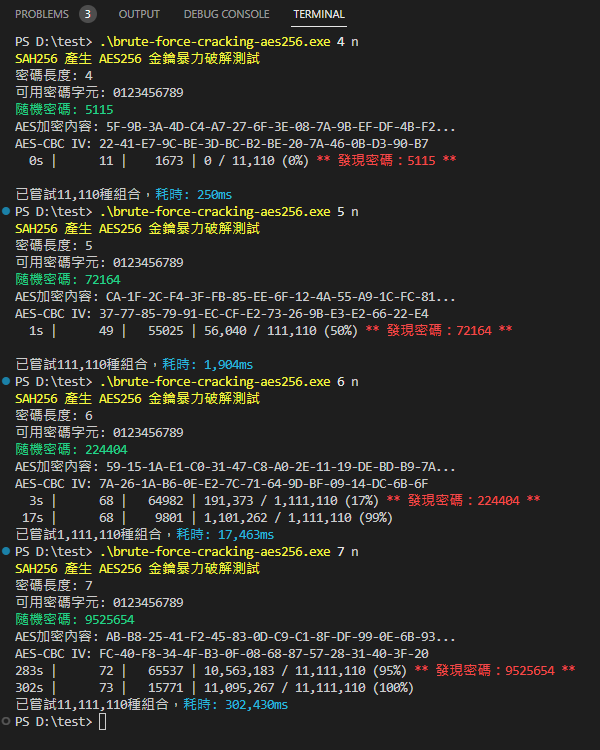
計算到七位數字時,建立 Task 丟給 ThreadPool 的方式雖然無腦又好寫,但需要建立超過 1,111 萬個物件,記憶體不時會衝上 3GB (等 GC 時再降下來),CPU 也無法吃滿 100% (CPU 總使用率約 85% 到 90%,.NET 程式部分不到 70%)
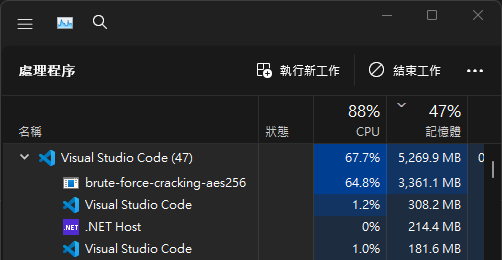
思考了一下,我想到可以用 IEnumerable + yield return 節省記憶體,再配合 Parallel.ForEach() 平行運算,修改成第二版:
//... 略 ...
long errCount = 0;
long completed = 0;
Task.Run(() =>
{
// 檢查 CancellationTokenSource 是否已經被取消
while (!cts.Token.IsCancellationRequested)
{
Console.CursorLeft = 0;
Console.Write($"{(DateTime.Now - startTime).TotalSeconds,3:n0}s | {completed:n0} / {total:n0} ({completed * 1.0 / total:p0}) | {errCount:n0}");
Thread.Sleep(1000);
}
},
cts.Token //允許還沒執行前取消(例如:還在 Queue 排隊時就取消)
);
var tasks = new List<Task>();
sw.Start();
Parallel.ForEach<string>(explore(""), new ParallelOptions { MaxDegreeOfParallelism = Environment.ProcessorCount * 2 },
(pwd) =>
{
if (token.IsCancellationRequested)
return;
try
{
var dec = CodecNetFx.AesDecrypt(pwd, ecn.data, ecn.iv);
if (dec.SequenceEqual(plain))
{
Console.ForegroundColor = ConsoleColor.Red;
Console.WriteLine($" ** 發現密碼:{pwd} **");
Console.ResetColor();
}
}
catch {
Interlocked.Increment(ref errCount);
}
finally
{
Interlocked.Increment(ref completed);
}
});
Console.WriteLine();
cts.Cancel();
sw.Stop();
Console.Write($"已嘗試{completed:n0}種組合,");
Console.ForegroundColor = ConsoleColor.Cyan;
Console.WriteLine($"耗時: {sw.ElapsedMilliseconds:n0}ms");
Console.ResetColor();
IEnumerable<string> explore(string currPwd)
{
if (!string.IsNullOrEmpty(currPwd))
yield return currPwd;
if (currPwd.Length < pwdLength)
{
foreach (var c in pwdChars)
{
foreach (var res in explore(currPwd + c))
yield return res;
}
}
}
yield return + Parallel.ForEach() 版在記憶體使用量及 CPU 使用率方面完勝遞迴 + Task.Run() 版本:
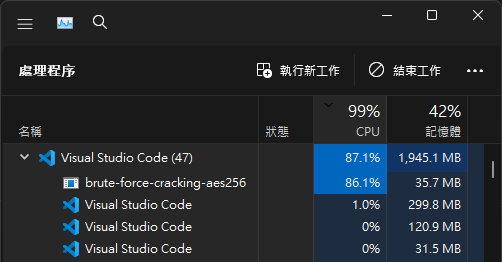
實測速度,6 位數字小輸 5 秒,7 位數字則快了 86s,整體效能有所改善。
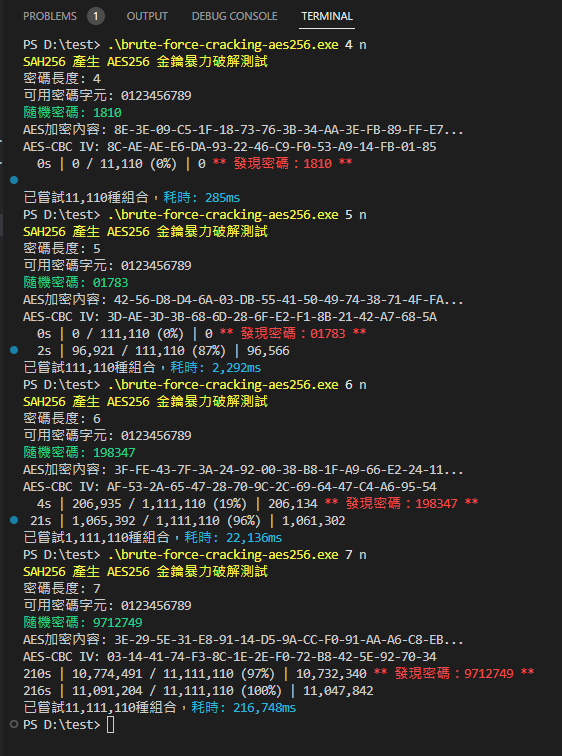
而由以上結果,用 7 位甚至 8 位純數字字串 SHA256 產生 AES 256 金鑰,一台普通 12 代 i5 不到一小時內就能破解。
至於密碼混合字母及符號的測試數據如下:
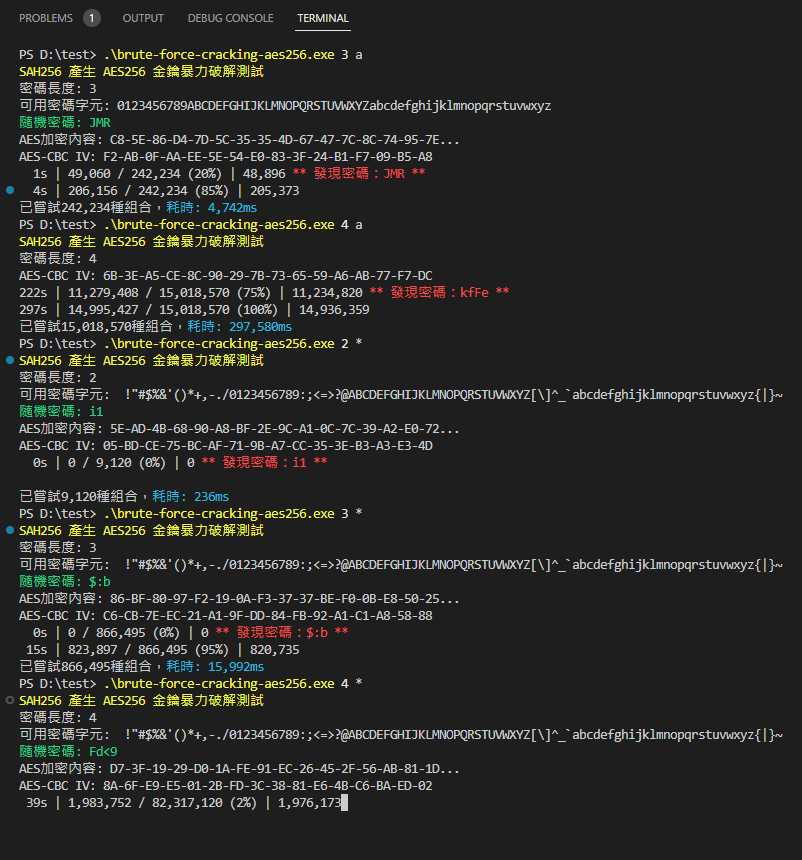
分析測試數據,耗用時間跟字元組合數量成正比,大致可推算出 50 次/ms,以此預估破解不同長度密碼所需時間如下表:
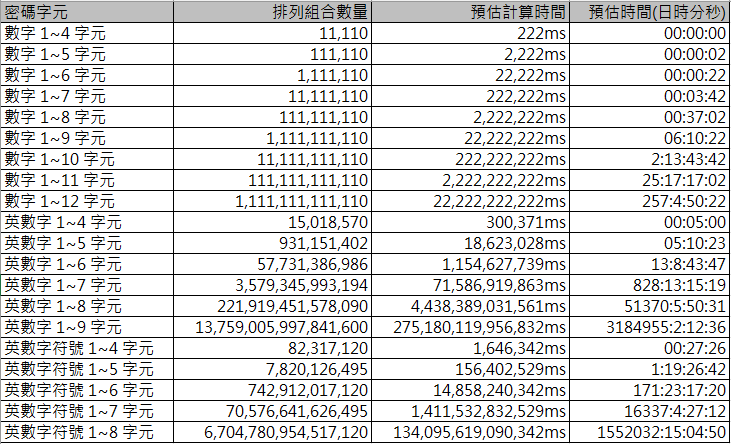
若用我的小 PC 跑破解,純數字 1 ~ 10 字元最多兩天、英數字 1 ~ 6 字元 13 天可破、英數字加符號 1 ~ 5 字元則需兩天,都在可接受範圍內;程式還有一堆待優化的地方(例如:使用字典檔常用字元縮小範圍、找更快的加密函式庫(至少 .NET 內建 API 比 BouncyCastle 快)、避開解密失敗 Catch Exception 的效能衝擊...),故以上數據要視為「非專業駭客使用家常設備發動的二流攻擊」,若是專業人士搭配八卡機,破解速度或許可再提高數十到數百倍。
至此,我們可得到結論:SCH 目前用 SHA256 產生金鑰的寫法確實不夠安全,靠家用 PC 跑非專業程式都有機會破解。我有想到一些簡單但能提高破解難度的點子,後面再來試試。
Recommend
About Joyk
Aggregate valuable and interesting links.
Joyk means Joy of geeK